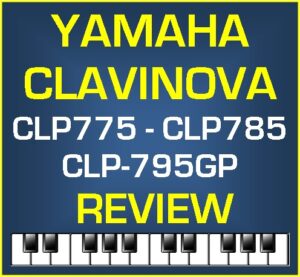 UPDATED REVIEW & COMPARISON | June 1, 2024 | Yamaha Clavinova CLP-775, CLP-785, CLP-795GP | The CLP-775, CLP-785, and CLP-795GP mini grand are now discontinued and will be replaced within the next few months with the new CLP-800 series including the CLP-875, CLP-885, and CLP-895GP. In the meantime the CLP-700 series are being cleared out at lower prices than normal, all of them first come first served.
UPDATED REVIEW & COMPARISON | June 1, 2024 | Yamaha Clavinova CLP-775, CLP-785, CLP-795GP | The CLP-775, CLP-785, and CLP-795GP mini grand are now discontinued and will be replaced within the next few months with the new CLP-800 series including the CLP-875, CLP-885, and CLP-895GP. In the meantime the CLP-700 series are being cleared out at lower prices than normal, all of them first come first served.INTRODUCTION of the 700 Series
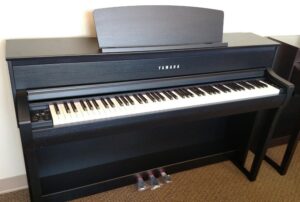 |
| CLP-775 matte black |
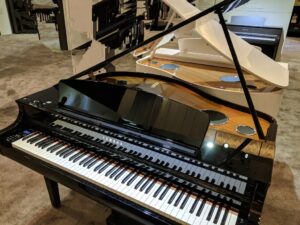 The following review is for the now discontinued 700 series and at their previous selling prices. The CLP-775 is the lowest priced model of the three top models and is offered in simulated rosewood, matte black, matte white, and matte walnut for $4999 internet discount price along with a polished ebony version at $5599 store discount price. The CLP-785 is offered in matte black for $6399 internet discount price along with a polished ebony version at $7199 store discount price and a polished white version at $8199 internet discount price.
The following review is for the now discontinued 700 series and at their previous selling prices. The CLP-775 is the lowest priced model of the three top models and is offered in simulated rosewood, matte black, matte white, and matte walnut for $4999 internet discount price along with a polished ebony version at $5599 store discount price. The CLP-785 is offered in matte black for $6399 internet discount price along with a polished ebony version at $7199 store discount price and a polished white version at $8199 internet discount price.
The newer CLP-795GP (GP stands for “grand piano”) in polished ebony is priced on-line at $8199 discount price and the polished white color was $9199 discount price, but now has a factory instant rebate bringing the price of the polished white cabinet model down to $7999 for a limited time. The CLP-795GP mini grand has the same functions and features as the the upright CLP-785 except it’s in a larger 4′ deep grand style cabinet which is the highest priced model of the three models.
KEY ACTION
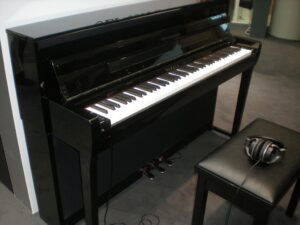 |
| CLP785 polished ebony |
As far as key action goes in these three models, without a doubt this portion of any piano is the most important part of the “piano playing experience.” There are a variety of different piano key actions in both acoustic and digital pianos including all the major brands and they all claim to have this “secret sauce” as I call it. When it comes to producing what they think is a great key action that can handle all of a player’s musical needs and desires for an expressive keyboard playing experience, they all try to make you believe that they offer the best most realistic key action. Some of them actually are impressive and expressive key actions to play and others aren’t so great regardless of what the manufacturers would otherwise claim in their marketing and promotion advertising. Most people would expect that the more money you pay for a piano instrument, the better and more responsive the key action will be, therefore producing an even greater amount of playing enjoyment. But unfortunately, that is not necessarily true as is the case in my opinion concerning the new CLP-775.

Although the CLP-775, CLP-785, and CLP-795GP mini grand use the same Grandtouch keys, the CLP-785 and CLP-795GP are different than the CLP-775 because the keys on the CLP-785 and CLP-795GP have counterweights inside of them which creates a noticeably more balanced, more responsive, and lighter key action response as compared to the CLP-775. On the lower priced Yamaha CLP-745 at $3799, it has a different key action with shorter keys called GrandTouch-S 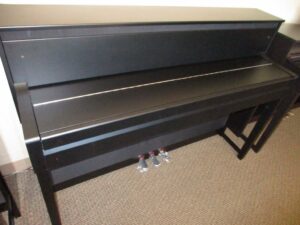 which offers wood keys (white keys only) which I like, so I was looking forward to playing and enjoying the new longer key GrandTouch wood key action in the new CLP-775, CLP-785, and CLP-795GP.
which offers wood keys (white keys only) which I like, so I was looking forward to playing and enjoying the new longer key GrandTouch wood key action in the new CLP-775, CLP-785, and CLP-795GP.
So when I would try to play the keys lightly and/or quickly, the keys just did not want to go down easily and an abnormal amount of finger force was needed to press the keys down as compared to areal Yamaha acoustic grand piano. It normally on average takes about 50 to 60 grams of touch weight force (measured in grams) to press down the middle C key on a good acoustic grand piano such as Yamaha. On digital pianos it can go on average from 55 grams to about 75 grams of touch weight on middle C depending on the brand and model of digital piano. Key actions in digital pianos seem to vary a lot more more than in acoustic pianos. Measurements are also taken on the middle C# key (black key) because those keys move differently than white keys as they are shorter.
On digital pianos, if the touch weight on middle C goes from about 55 grams on middle C to approx 75 grams, then those key actions are certainly playable as long as they don’t have a sluggish key return force (upweight) that would slow down the key too much when it tries to come back up. You never really want a slow return of the key to resting position relative to the down-weight. However, the heavier the “touch weight” then the more effort your hands, fingers, and wrists need to exert in playing the piano. So the key weight and balance between the down and up movement of the keys along with the fulcrum point of the keys including length of keys is very important.
When Yamaha says “GrandTouch” keys are in their 775, 785, and 795GP digital pianos, those keys are all the same construction and length, but they do not have the same weight.. This is primarily because the keys in the 785 and 795GP have physical counter-weights built into each white key. However, on the CLP-775 there are no counter-weights and that small but very important detail can be found in the spec sheet of those Yamaha pianos. Why Yamaha did not put the exact same key action in all 3 models, I can only speculate that it had to do with cost. But I would have paid a bit more for that counter-weight action to be in the CLP-775, and here’s why.
KEY ACTION CONTINUED – STATIC TOUCH WEIGHT
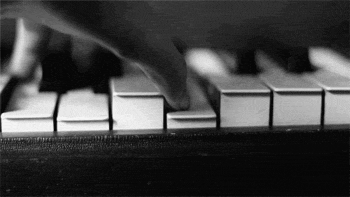 On the CLP-785 and 795GP (having the same key action), I measured the static touch weight (aka: down-weight) on the middle C key as being approx 75 grams and on the C# key it was approx 73 grams of finger force needed to press down the key from a resting position. So that action is somewhat firm but not out of range and not “heavy.” However, I measured the static touch weight on the CLP-775 as being a bit over 85 grams on middle C and on the C# key it was about 79 grams of force needed. In other words, based on my measurements and my personal experience playing the CLP-775, that key action was noticeably heavier when I played it, and personally I don’t care for a noticeably heavier key action playing experience. Any key action with a static touch weight at or above 80 grams is considered somewhat heavy, especially when playing softer and lighter musical passages.
On the CLP-785 and 795GP (having the same key action), I measured the static touch weight (aka: down-weight) on the middle C key as being approx 75 grams and on the C# key it was approx 73 grams of finger force needed to press down the key from a resting position. So that action is somewhat firm but not out of range and not “heavy.” However, I measured the static touch weight on the CLP-775 as being a bit over 85 grams on middle C and on the C# key it was about 79 grams of force needed. In other words, based on my measurements and my personal experience playing the CLP-775, that key action was noticeably heavier when I played it, and personally I don’t care for a noticeably heavier key action playing experience. Any key action with a static touch weight at or above 80 grams is considered somewhat heavy, especially when playing softer and lighter musical passages.Once you get the keys moving and you apply constant finger force while playing, you can certainly play that model and be ok. But if you are just playing recreationally to enjoy playing your favorite music and you want to have a comfortable and responsive playing experience and not get hand and wrist fatigue, especially when playing more lightly, softly, and repetitively, in my opinion the CLP-775 key action is far too heavy for its down/touch weight across the keys.
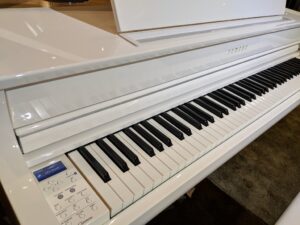 It would be much better to go up to the CLP-785, CLP-795GP, or down to the CLP-745 (for less money) which have a somewhat lighter (and more normal) touch-weight force measured on middle C. Since there is no way to change the physical weighting of the keys themselves, then your only option is to change the velocity touch curve and that may help a bit, but it doesn’t address the actual key resistance and weight issue.
It would be much better to go up to the CLP-785, CLP-795GP, or down to the CLP-745 (for less money) which have a somewhat lighter (and more normal) touch-weight force measured on middle C. Since there is no way to change the physical weighting of the keys themselves, then your only option is to change the velocity touch curve and that may help a bit, but it doesn’t address the actual key resistance and weight issue.
In the 700 series Yamaha has improved their key actions a bit in that way on all 3 models, but they are still somewhat noisy/thumpy and that is noticeable on the 785/795GP, at least it is to me. The ambient noise of the moving keys is less now than in prior models as they go down & back up.
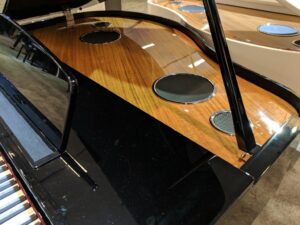 I have played top of the line Yamaha, Steinway, Bosendorfer, and other famous grand pianos and my experience on those grands with regard to key action was almost always good and very enjoyable to play with quick, relatively lighter weight responsive keys. With regard to the CLP-775, Yamaha says in their marketing ads a lot of very positive things, and as they should because there are definitely some areas of the key action that I like such as longer, better balanced keys and more realistic fulcrum point so that the finger pressure needed for playing anywhere on the keys (both black & white keys or front to back of key) is more even and a bit closer to a grand piano in that way.
I have played top of the line Yamaha, Steinway, Bosendorfer, and other famous grand pianos and my experience on those grands with regard to key action was almost always good and very enjoyable to play with quick, relatively lighter weight responsive keys. With regard to the CLP-775, Yamaha says in their marketing ads a lot of very positive things, and as they should because there are definitely some areas of the key action that I like such as longer, better balanced keys and more realistic fulcrum point so that the finger pressure needed for playing anywhere on the keys (both black & white keys or front to back of key) is more even and a bit closer to a grand piano in that way.
KEY ACTION – ESCAPEMENT FEATURE
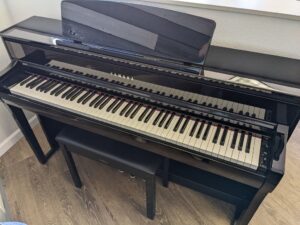 There is something else I want to mention about the key action and it has to do with the “escapement” portion of the key action on all three models. Escapement is a term used to describe what happens in an acoustic grand piano when you press down the keys more slowly and lightly. About half-way down in the key travel you will notice a slight hesitation or “bump in the road” as you press the key all the way down. This “feeling” that you will get as you are depressing the keys is due to the way acoustic grand piano key actions work. You don’t feel this so-called “bump or hesitation” when playing the keys faster and a bit harder. It’s only when you are playing more lightly and/or slowly that you will feel it.
There is something else I want to mention about the key action and it has to do with the “escapement” portion of the key action on all three models. Escapement is a term used to describe what happens in an acoustic grand piano when you press down the keys more slowly and lightly. About half-way down in the key travel you will notice a slight hesitation or “bump in the road” as you press the key all the way down. This “feeling” that you will get as you are depressing the keys is due to the way acoustic grand piano key actions work. You don’t feel this so-called “bump or hesitation” when playing the keys faster and a bit harder. It’s only when you are playing more lightly and/or slowly that you will feel it.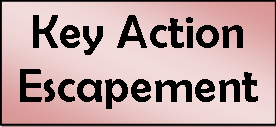 You won’t feel this same thing happen in acoustic upright pianos, only in grand pianos. The real question is…”is it necessary.” The answer is…for recreational piano playing…not really. There are some more advanced piano players that like to play on acoustic grand pianos and have that escapement notch/hesitation feeling because it can give them the sense of having more control over their music when playing in a certain way, especially for more complex classical or jazz music and playing more softly and/or slowly.
You won’t feel this same thing happen in acoustic upright pianos, only in grand pianos. The real question is…”is it necessary.” The answer is…for recreational piano playing…not really. There are some more advanced piano players that like to play on acoustic grand pianos and have that escapement notch/hesitation feeling because it can give them the sense of having more control over their music when playing in a certain way, especially for more complex classical or jazz music and playing more softly and/or slowly.However, in a digital piano, overall I don’t feel it’s necessary for most recreational players, but the manufacturers try to simulate this “notch feeling” in many of their digital pianos including their upright style digital pianos. They would say that they are trying to give you this “grand piano” key action feeling in not only a digital grand piano shaped instrument, but also in a vertical upright digital piano. Top name brands such as Yamaha offers this feature in all of their Clavinova models, Roland offers it in nearly all of their models, and Kawai offers it in many of their digital piano models.
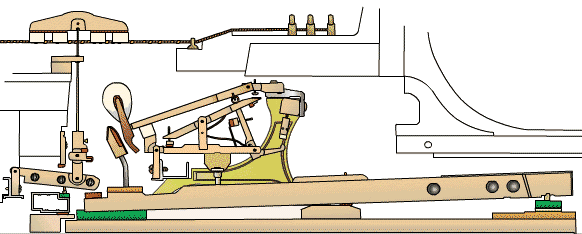
If you look at the escapement demo GIF above you’ll see what the escapement movement looks like when a key is slowly depressed in a real grand piano In a digital piano the escapement mechanism is “simulated” and there are no moving hammers or extra parts as you would find in a real acoustic piano.
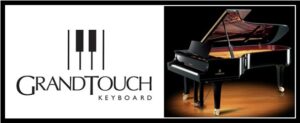 When it comes to these 3 Yamaha digital pianos we are talking about here, Yamaha has tried to recreate that escapement feature in their GrandTouch key actions. This is not new for them because they had it in their previous CLP600 series and models previous to that. But what makes it different in the 700 series is that the escapement feature in the new key actions is much better and more realistic. Is it just like an acoustic grand piano? The answer would be no. But in the previous model 600 series, the escapement feature (aks: let-off) was not good at all because you could hardly feel it as if it was not there. In my opinion it was just poorly done.
When it comes to these 3 Yamaha digital pianos we are talking about here, Yamaha has tried to recreate that escapement feature in their GrandTouch key actions. This is not new for them because they had it in their previous CLP600 series and models previous to that. But what makes it different in the 700 series is that the escapement feature in the new key actions is much better and more realistic. Is it just like an acoustic grand piano? The answer would be no. But in the previous model 600 series, the escapement feature (aks: let-off) was not good at all because you could hardly feel it as if it was not there. In my opinion it was just poorly done.SPECIAL FEATURES
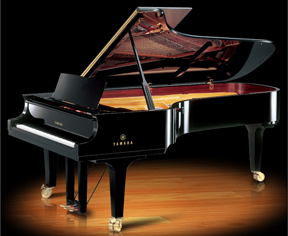 Now on to the piano sound realism and other features. all 3 of these Yamaha Clavinova pianos share the identical acoustic piano sounds with the Yamaha and Bosendorfer grand piano sounds, the identical user touch control panels, and many of the same digital features including reverb, effects, piano room editing, transpose, drum rhythms, and individual sounds and tone editing. However, the CLP-785/CLP-795GP has many extra added instrument sounds over the CLP-775 with a proprietary Yamaha sound library. This would include 53 proprietary instrument tones developed for the CLP-785/CLP-795GP along with 480 Yamaha standard XG instruments. The CLP-775 is limited to 38 total instrument sounds and does not have the XG sound library built in.
Now on to the piano sound realism and other features. all 3 of these Yamaha Clavinova pianos share the identical acoustic piano sounds with the Yamaha and Bosendorfer grand piano sounds, the identical user touch control panels, and many of the same digital features including reverb, effects, piano room editing, transpose, drum rhythms, and individual sounds and tone editing. However, the CLP-785/CLP-795GP has many extra added instrument sounds over the CLP-775 with a proprietary Yamaha sound library. This would include 53 proprietary instrument tones developed for the CLP-785/CLP-795GP along with 480 Yamaha standard XG instruments. The CLP-775 is limited to 38 total instrument sounds and does not have the XG sound library built in.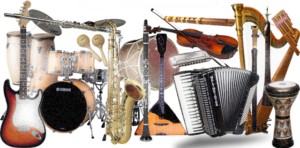 The Yamaha XG instrument library in the CLP785 and CLP795GP consists of a huge sound library of additional orchestral, band, percussive tones, guitars, etc, etc, and special effects sounds. One of the biggest benefits to this XG library of instrument sounds is that they are useful for playing a variety of additional tones such as sax, trumpet, guitars, banjos, synths, and all kinds of instrument tones and special effects. Another important aspect of the XG instrument sound library is that it’s compatible with playing General MIDI song files including song play formats by other digital piano manufacturers. So if you want to find and download musically exciting MIDI song files from just about any composer or song you can think of, you can do that on-line and then put them on a USB flashdrive and have the CLP-785/CLP-795GP playback those songs at any speed and/or key.
The Yamaha XG instrument library in the CLP785 and CLP795GP consists of a huge sound library of additional orchestral, band, percussive tones, guitars, etc, etc, and special effects sounds. One of the biggest benefits to this XG library of instrument sounds is that they are useful for playing a variety of additional tones such as sax, trumpet, guitars, banjos, synths, and all kinds of instrument tones and special effects. Another important aspect of the XG instrument sound library is that it’s compatible with playing General MIDI song files including song play formats by other digital piano manufacturers. So if you want to find and download musically exciting MIDI song files from just about any composer or song you can think of, you can do that on-line and then put them on a USB flashdrive and have the CLP-785/CLP-795GP playback those songs at any speed and/or key.YAMAHA ACOUSTIC PIANO SOUNDS
As far as the new Yamaha piano sound engine including recorded piano samples from the latest Yamaha Concert Grand and European Bosendorfer Concert Grand, I do like the new acoustic piano sound authenticity very much. They have greatly been improved from the previous models. There is a real feeling of “presence” to the stereo grand piano sounds that gives you the feeling of hearing “the real thing” The Yamaha CFX acoustic piano sound is brighter and punchier like the “real thing” and is great for pop, rock, Latin, country, and other forms of non-classical music.
USER INTERFACE PANEL
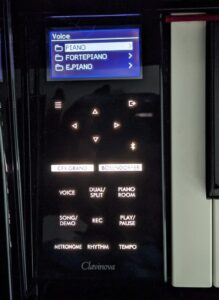 Accessing these sounds and related functions in the CLP-775, 785, and 795-GP from their side control touch panels is a new feature for Yamaha. Up until now Yamaha has not had touch control panels in the CLP piano lineup before. They have always used traditional buttons like they still do in their lower priced Clavinova pianos. The new larger touch control panels have the same size “screens” and those screens are not touch sensitive, but the entire control panel underneath those display screens has lighted “touch buttons” on it for all 3 digital piano models and they are very impressive and work well.
Accessing these sounds and related functions in the CLP-775, 785, and 795-GP from their side control touch panels is a new feature for Yamaha. Up until now Yamaha has not had touch control panels in the CLP piano lineup before. They have always used traditional buttons like they still do in their lower priced Clavinova pianos. The new larger touch control panels have the same size “screens” and those screens are not touch sensitive, but the entire control panel underneath those display screens has lighted “touch buttons” on it for all 3 digital piano models and they are very impressive and work well.You can even have the panel display lighted touch buttons turn off and go black after a certain time frame (that you can set) if you choose to do that. When the touch panel is in the “dimmed” black mode including the display screen itself, then it doesn’t look like there are any controls on the piano and that feature makes the piano look less “digital” and even more like an acoustic piano. The touch screen is also fairly intuitive and I like it and I have used many touchscreens on various digital pianos. The only other top name digital piano company that uses buttonless touch control is Kawai.
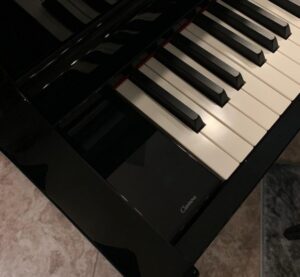 However, Kawai uses a larger color touch screen about the same size as the Yamaha control panel & screen. The difference is that the color screen is all touch sensitive like your mobile phone and it also uses icons for navigation on the screen which is pretty cool. Nevertheless, the Yamaha touch panel seems to be more than sufficient to get the job done and look good at the same time.
However, Kawai uses a larger color touch screen about the same size as the Yamaha control panel & screen. The difference is that the color screen is all touch sensitive like your mobile phone and it also uses icons for navigation on the screen which is pretty cool. Nevertheless, the Yamaha touch panel seems to be more than sufficient to get the job done and look good at the same time.SMART PIANIST INTERACTIVE APP
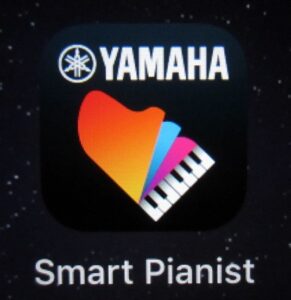 For people who love technology, have an iPad, and want even more intuitive control and access to the features on these pianos, Yamaha has a proprietary app called Smart Pianist. This app allows you to control the various functions and features of these pianos from the color touch screen of your external device. Not only is this app very intuitive to use, accessing the hundreds of features and functions on the CLP-785 and CLP-795GP is so much easier to do.
For people who love technology, have an iPad, and want even more intuitive control and access to the features on these pianos, Yamaha has a proprietary app called Smart Pianist. This app allows you to control the various functions and features of these pianos from the color touch screen of your external device. Not only is this app very intuitive to use, accessing the hundreds of features and functions on the CLP-785 and CLP-795GP is so much easier to do.In fact, without this Smart Pianist app, you may not use many of these cool sounds and functions that these 2 pianos provide because it is more cumbersome to access them from the piano control panel menu as compared to this easy-to-use app. Also, the app allows you to access a big library of digitized sheet music so that you can learn and play along with a variety of these songs which encompass both classical and non-classical music. Beyond that, the Smart Pianist app can instantly analyze MP3 song files from iTunes and provide an instant chord chart for you directly in the song along with lyrics with songs that have them.
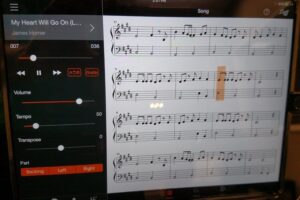 You can also more intelligently use and understand the multiple recording and playback features in these 3 pianos including the impressive 16-track recorder and also the audio wav file recorder. You can certainly use those functions directly from the piano control panel But when the features of the piano become a bit more complex, most of that complexity is removed by using the Smart Pianist app from your external device (ie: iPad). Personally,
You can also more intelligently use and understand the multiple recording and playback features in these 3 pianos including the impressive 16-track recorder and also the audio wav file recorder. You can certainly use those functions directly from the piano control panel But when the features of the piano become a bit more complex, most of that complexity is removed by using the Smart Pianist app from your external device (ie: iPad). Personally,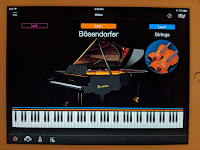 I love using this kind of technology if it helps me get more musical enjoyment out of my piano playing and using features that I may not otherwise use. So when it comes to utilizing all the impressive features of all 3 of these models, but especially the 785 and 795, the Smart Pianist app is an invaluable tool for getting more musical enjoyment out of these new models.
I love using this kind of technology if it helps me get more musical enjoyment out of my piano playing and using features that I may not otherwise use. So when it comes to utilizing all the impressive features of all 3 of these models, but especially the 785 and 795, the Smart Pianist app is an invaluable tool for getting more musical enjoyment out of these new models.
PEDALS
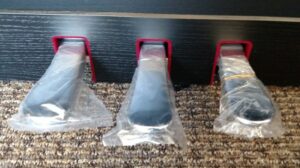 As far as pedaling goes on the CLP-775, CLP-785, and CLP-795GP, all three of these pianos have the upgraded grand piano damper pedal feel as opposed to the upright or normal pedaling feel that is found on the CLP-745 and below. Other digital piano companies have this type of feature which is also called “grand feel” pedaling as well and what they do is make the resistance of the pedals to your foot pressure a bit lighter when you initially press the pedals down and then the pedal gradually feels like it is getting firmer to push down or more resistant to your foot pressure as you press it down further.
As far as pedaling goes on the CLP-775, CLP-785, and CLP-795GP, all three of these pianos have the upgraded grand piano damper pedal feel as opposed to the upright or normal pedaling feel that is found on the CLP-745 and below. Other digital piano companies have this type of feature which is also called “grand feel” pedaling as well and what they do is make the resistance of the pedals to your foot pressure a bit lighter when you initially press the pedals down and then the pedal gradually feels like it is getting firmer to push down or more resistant to your foot pressure as you press it down further.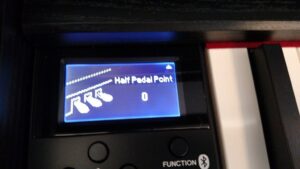
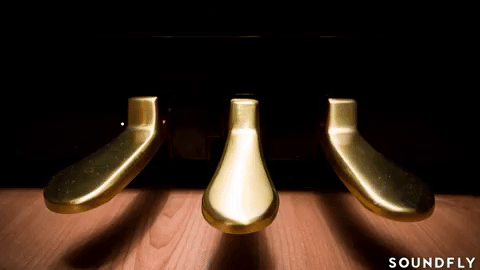 Some are heavier overall and some lighter, and yes, some adjustments can be made to that acoustic pedaling movement. But as far as the CLP-775, CLP-785, and CLP-795GP go, the pedaling is very nice and for some people the grand pedal feel on the right pedal (aka: GP response damper pedal) would be a benefit. But for other people playing at a lower recreational skill level, just having a decent smooth pedal movement may be all they really need which is what you would find on both the lower priced Yamaha Clavinova CLP-735 and CLP-745, assuming you need to be in a lower price range.
Some are heavier overall and some lighter, and yes, some adjustments can be made to that acoustic pedaling movement. But as far as the CLP-775, CLP-785, and CLP-795GP go, the pedaling is very nice and for some people the grand pedal feel on the right pedal (aka: GP response damper pedal) would be a benefit. But for other people playing at a lower recreational skill level, just having a decent smooth pedal movement may be all they really need which is what you would find on both the lower priced Yamaha Clavinova CLP-735 and CLP-745, assuming you need to be in a lower price range.INTERNAL SOUND SYSTEM
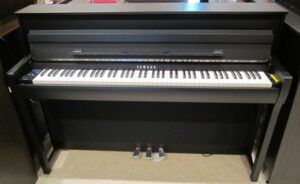
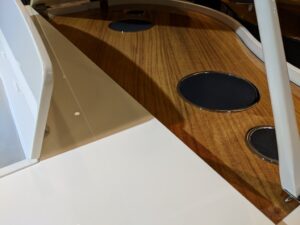 The internal sound system in all three of these new models are significantly louder and fuller than on the lower priced models. This will help when playing at softer volumes because the extra power helps to increase the richness of the sound when playing at lower volumes. On the CLP-775 the internal speaker system consists of a huge 284 watts of power going through 6 separate amplifiers and 6 speakers plus 2 transducers with part of system enclosed in a separate speaker box under the piano. The top of the line CLP-785 and CLP-795GP mini grand have the same sound system in both models which includes a whopping 300 watts of total power each going through 6 amplifiers and 6 speakers plus 2 transducers.
The internal sound system in all three of these new models are significantly louder and fuller than on the lower priced models. This will help when playing at softer volumes because the extra power helps to increase the richness of the sound when playing at lower volumes. On the CLP-775 the internal speaker system consists of a huge 284 watts of power going through 6 separate amplifiers and 6 speakers plus 2 transducers with part of system enclosed in a separate speaker box under the piano. The top of the line CLP-785 and CLP-795GP mini grand have the same sound system in both models which includes a whopping 300 watts of total power each going through 6 amplifiers and 6 speakers plus 2 transducers.
CABINET DESIGN
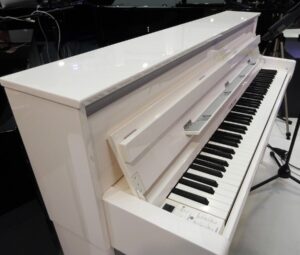 |
| CLP-785 polished white |
As for any other differences between the vertical CLP-775 and CLP-785 go, the cabinet design is noticeably different with the CLP-785 being more contemporary, streamlined, and having a different look as well as the CLP-785 being almost 3″ taller and also about 30 lbs heavier than the CLP-775, so it is more substantial. I do like the more upgraded cabinet of the CLP-785 as compared to the CLP-775. The CLP-785 also has a unique slow-close folding key cover as opposed to the more traditional sliding key cover on the CLP-775 like all the other CLP models have so I do like that feature very much on the CLP-785. The CLP-785 music rack works nicely and supports sheet music with its built-in sheet music holders in the music rack itself so that is a very nice touch in this new model over the previous one. The CLP-795GP mini grand is obviously different in cabinet design than the other two and is very elegant in its appearance. So you would just need to decide if you want a vertical upright style or a grand piano style, and if your choice is affordable for you.
BLUETOOTH WIRELESS CONNECTIVITY
 Yamaha previously has Bluetooth audio streaming in their prior models and they still have it in these new pianos so that you can stream your favorite tunes from your external device into the piano speaker system. Then you can play along with your favorite songs and even hear it all through headphones for private practice.
Yamaha previously has Bluetooth audio streaming in their prior models and they still have it in these new pianos so that you can stream your favorite tunes from your external device into the piano speaker system. Then you can play along with your favorite songs and even hear it all through headphones for private practice.BINAURAL SAMPLING FOR HEADPHONES
Yamaha also makes a big deal about their headphone circuitry technology which they call Binaural sampling. This technology allows you to wear standard plug-in stereo headphones and be able to experience a more natural “surround sound” type of piano playing experience through headphones. Yamaha had it in their previous models for the Yamaha CFX piano sound only, but they did not have it for their Bosendorfer piano sound. Without that Binaural technology being available for the Bosendorfer sound through headphones, the CFX piano sounded great, but the Bosendorfer piano sounded plain and not even close to the Yamaha piano sound through headphones.
Through the internal speaker system everything sounded great…but through headphones only the Yamaha piano sound sample was enjoyable. But now Yamaha has been able to include the beautiful Bosendorfer piano sound in their Binaural technology and when you listen to both piano sounds through a good pair of standard headphones then both sound very resonant and full and spatially pleasing to the ears.
FINAL THOUGHTS
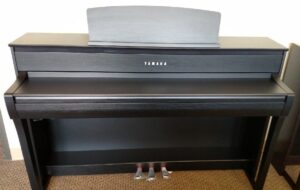 |
| CLP-775 with closed cover |
At the end of the day, playing and enjoying the piano is all about how it makes you feel when you touch, feel, and look at your new instrument. Yamaha certainly does produce some great digital pianos including top notch acoustic pianos and I have played many of them for years. But at least for me, I would definitely opt for the higher priced CLP-785 or CLP-795GP over the CLP-775 Clavinova primarily because I would much prefer a much more responsive and quicker playing key action that feels good in terms of weight and the way it moves under your fingers
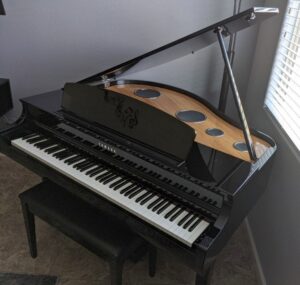 I also really like the design and appearance of the CLP-785 as compared to the CLP-775. The CLP-795GP mini grand has a beautiful polished wood grain interior color that is quite striking and elegant in contrast to its attractive exterior cabinet colors (in both black or white cabinet), and I have not seen this design or materials used in any digital grand piano cabinet before now. In my opinion it is worth it to go up to the CLP-785 or CLP-795GP, especially for a longer term purchase that you’ll keep for many years…even decades.
I also really like the design and appearance of the CLP-785 as compared to the CLP-775. The CLP-795GP mini grand has a beautiful polished wood grain interior color that is quite striking and elegant in contrast to its attractive exterior cabinet colors (in both black or white cabinet), and I have not seen this design or materials used in any digital grand piano cabinet before now. In my opinion it is worth it to go up to the CLP-785 or CLP-795GP, especially for a longer term purchase that you’ll keep for many years…even decades.Along with its sliding key cover, 1-position fully opened lid prop, and minimalistic digital user touch interface on the left side of the keyboard, the CLP-795GP mini grand at $8199 for the popular polished ebony color is a clear winner for Yamaha and it really is a beautiful piece of furniture especially with its polished wood-grain interior soundboard/speaker area. The lower priced CLP-745 model that have written about in another review is also a good choice and one you should consider over the CLP-775 if you prefer to be in a lower price range and want a quick and lighter key action as compared to the CLP-775. The piano sound-chip and most other functions on the lower priced Clavinovas are very similar to the higher top end CLP-775.
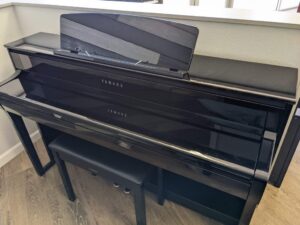 Yamaha did a great job of giving the lower priced CLP-745 at $3799 for matte finish and $4299 for polished ebony finish (which I have talked about in another review) some of the important features of the higher priced CLP-775 while still offering a satisfying piano key action playing experience in my opinion. However, even with the heavier key action there are some people who may like the new CLP-775 because of that key action. You may be one of those people and if you are then buy it. I like everything else about that model and it is impressive in all those other ways.
Yamaha did a great job of giving the lower priced CLP-745 at $3799 for matte finish and $4299 for polished ebony finish (which I have talked about in another review) some of the important features of the higher priced CLP-775 while still offering a satisfying piano key action playing experience in my opinion. However, even with the heavier key action there are some people who may like the new CLP-775 because of that key action. You may be one of those people and if you are then buy it. I like everything else about that model and it is impressive in all those other ways.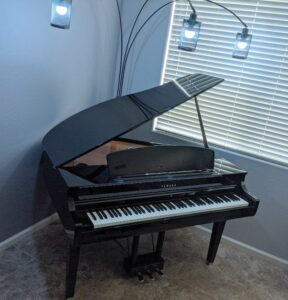 If you decide you want a 4′ deep size digital baby grand then the new Yamaha CLP-795GP would be my recommendation over any other brands and models in this price range. In fact, the CLP-795GP has become so popular for Yamaha since they introduced it, Yamaha has been running out of stock on that model fairly often because of the strong demand for them right now and the shortage of computer chips to make them. So you may have to wait awhile to get one, but the sooner you put in an order to get on their reservation list for any of these models, the sooner you will get one and hopefully avoid another price increase which has been happening lately.
If you decide you want a 4′ deep size digital baby grand then the new Yamaha CLP-795GP would be my recommendation over any other brands and models in this price range. In fact, the CLP-795GP has become so popular for Yamaha since they introduced it, Yamaha has been running out of stock on that model fairly often because of the strong demand for them right now and the shortage of computer chips to make them. So you may have to wait awhile to get one, but the sooner you put in an order to get on their reservation list for any of these models, the sooner you will get one and hopefully avoid another price increase which has been happening lately.FACTORY WARRANTY & CONCLUSION
Any of these pianos may be a perfect choice for you (depending on what you want) and they come with the Yamaha 5 year factory parts & labor warranty with in-home service. Yamaha also includes a very nice matching bench with their pianos that look great. If you want a very reliable piano that will likely last you for many years (even decades) and give you a very satisfying playing playing experience, depending on your musical goals, experience, and the budget that you have, then you cannot go wrong in choosing a Yamaha digital piano.
This company has definitely made a big name for themselves over the years and I have personally played on literally hundreds of Yamaha and Bosendorfer acoustic pianos, digital pianos, and keyboards and they are very impressive. Let me know if you have questions and contact me!
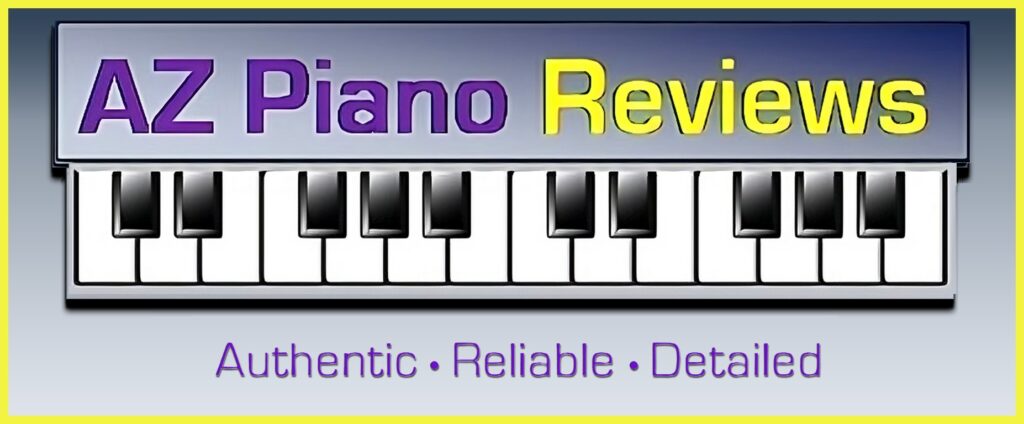



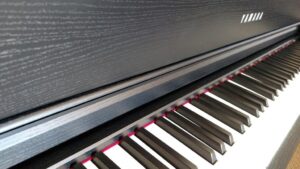
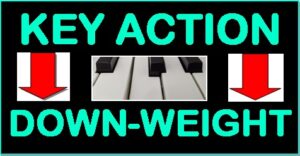
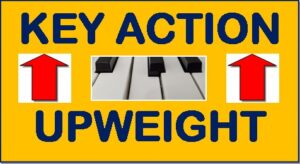
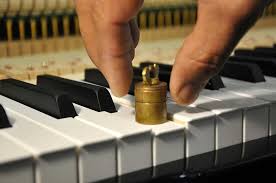
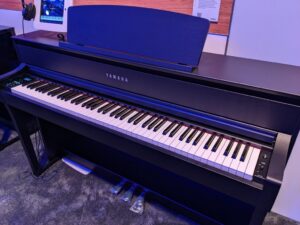
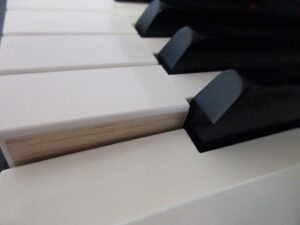
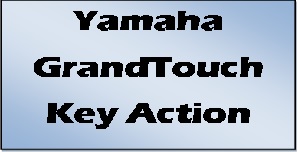
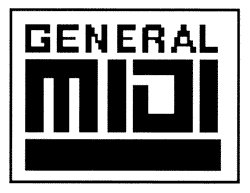
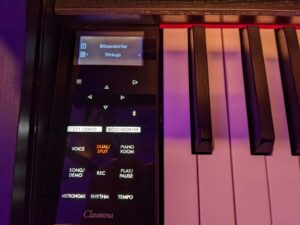
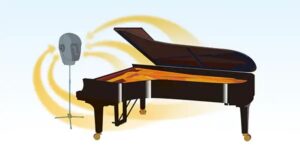
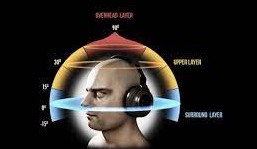




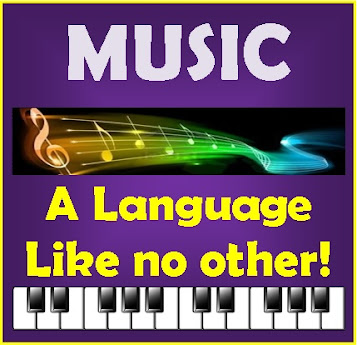
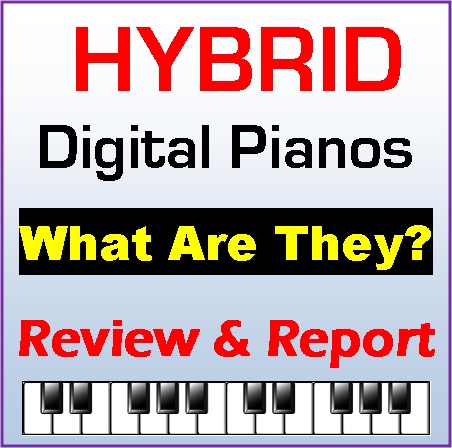
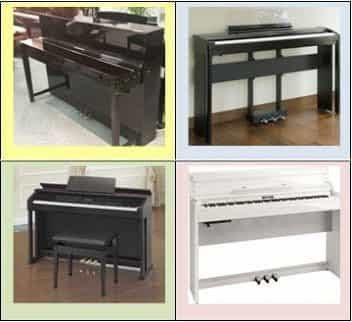
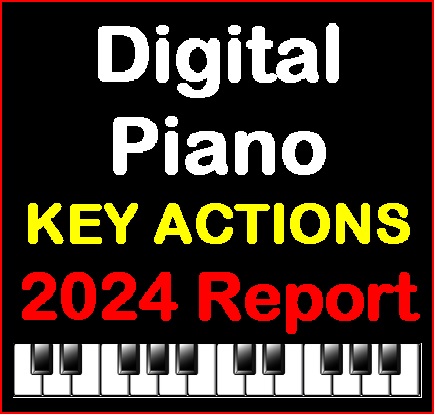
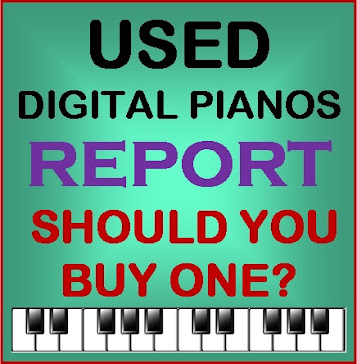
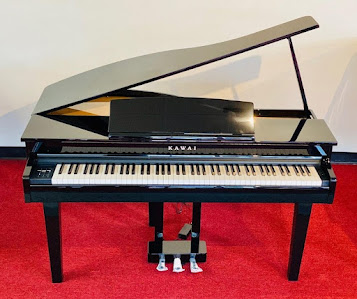
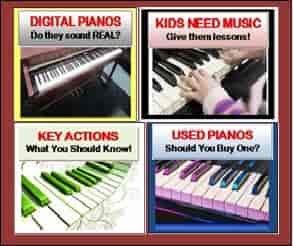
The heavy key action of the CLP 685 is the reason why I bought an old 585 with a noticably lighter action instead. And even the 585 has a heavier touch (around 62g) than a real grand piano like a Steinway (around 47g). I didn't measure the CLP 685 downweight, but I think I would be around 80g. If you want a downweight like at a real grand piano you have to choose Kawai.
We recently bought a CLP685.
I wish I has seen this review before, we are inexperienced "pianists"!
In the shop I did not notice that the keys require much more
force then our old Petrof.
It is more difficult to play softer phrases because of the relative
high minimum key force. Indeed the keys are also unnecessary noisy
for a digital piano.
The pedals spring-load is also unnecessary high, en they are noisy too!,
a plasic notch scratces in the metal frame. The pedals unit is a
cheap construction with too much side play, the red felt is only there for the nice.
We are disappointed with this piano,
Yamaha should have build something better for this price.
Thank you
I bought a clp-675 despite not having played it, primarily because it was offered to me at a little more than a 645 (which was my original aim)
I was assured that the grand key action was superior on the 675, which it is I guess to an
extent.
It’s an absolutely fantastic piano but it’s heavy with unnecessary noise.
I don’t want to pigeon hole the series but I will. In my opinion, the best in the 6 series are 685,645,675.
If you’re a midranger like me, please go and play these pianos.
The best analogy I can come up with, which is of course wholly subjective is that the clp-675 feels like a downgrade from the 685 and not an upgrade from the 645.
it's interesting that some people do shopping research AFTER they purchase a digital piano rather than before. It's risky in my opinion to trust a local or on-line store salesperson with what they are promising or assuring you of when it comes to buying a digital piano from them. I pointed out in this review concerning the CLP675 that the key action was extra firm (heavy) and also made unnecessarily loud key movement noise and my very experienced opinion concerning these models should be taken seriously before buying. Playing them in person can help but unless you have piano playing experience you may not recognize the shortcomings of the piano right away until after you buy it. Ultimately it's really no fun to play a piano of any type if your hands, fingers, and ears will not be enjoying the experience. A "good deal" is only a good deal if you like what you get. I wonder why the salesperson/store was so anxious to give you a "good price" on the CLP675? Maybe they knew it was just like you said and wanted to move it as fast as they could because they did not like it either? Regardless, I would try to get my money back (at least as much back as possible) rather than live with something you are not going to enthusiastically enjoy for the rest of your life.
I have to agree with Tim, Thanks for all your reviews Tim. Just bought my second DP(GP-400) and your review
spiked my interest in the GH line.
Well, let me retort.
My store had the clp 685,645 and (635), which i had a limited time to play.
I loved both but my budget would not stretch to the 685 (which i would have prefered)
Cue a month later and i was offered a new 675 for maybe £200 more than the 645, with, as you suspect assurances of the keystroke etc.
You did point this out in your review, however i was not privvy to this before my purchase. It can be difficult to source unbiased and objective reviews online.
I am happy with the piano, i'll leave others to dwell on what i've said comes from dissonance rather than professionalism but it does still feel fundamentally like a 685 downgrade rather than an upgrade from the 645
Hi Tim, in addition to my previous regarding Yamaha digital pianos, would it not be possible to provide as well as an opinion on key touch some hard facts such as actually measuring the keystroke downweight .Other factors easy to measure are Sustain and Resonance. Strike middle C fairly hard hold the key down and measure how long it takes for the sound to fade to nothing (you are looking for at least 10secs, an acoustic piano the sound will last 15-20secs) . Resonance by holding down silently the chord of C (C,E,G) and striking C an octave below, you should hear the Chord resonate as well as the single note.
Keystroke weight, Sustain and Resonance are the major factors differentiating digital from acoustic pianos, yet at the moment only player opinions are given. Perhaps because digital piano pianos are so bad, maybe if the hard facts were given the manufacturers might be persuaded to do better.
Hi Tim,
Thanks for your useful and good reviews!
I bought a CLP 685 last year. I had to buy it due to serious problems with my old upright Petrof…and with my neighbors too. :-))
It’s my first digital piano and I’m happy with it, despite the quite heavy and noisy key action. But I have to mention that after long playing sessions my thumbs and little fingers hurt a bit while playing wide chords and some fast passages. I realized it’s because the edges of the white keys are not perfectly smooth, especially the corners; they are slightly rough and sharp, and maybe it’s due to synthetic ivory. The seller claimed all Yamaha piano keyboards are made that way and nobody has never complained about that. Are my fingers too delicate? Your opinion as an expert would be appreciated.
Regards,
Giulia Rella (from Italy)
As far as I can tell the clp695 keyboard is approximately 6-7cm lower than the standard keyboard on an acoustic baby grand. Is this correct? and would that be to low for someone keen to continue their piano exams beyond grade 6? I am in Australia and our Music Examinations Board assesses students to te same high standards as the British Music Examinations Board. Thankyou
Thanks for your reviews Tim!! I am upgrading from the older model yamaha clp-465gp to the clp695, and was curious as to the difference in action / sound between the two. I already sold my 465, and have not found a store near me that carries the 695 so unfortunately I have been unable to try it out myself. I know it is foolish to buy something you haven't tried but I have done as much research as possibly can, including watching all the videos on the 685/695 I can find. Anyways, I already put the $ down on the 695, and have to wait 2-4 weeks before the piano gets shipped to the local dealer in my city, and thought I might reach out to you to get your thoughts on the differences. I should add that I am looking to upgrade primarily for key action as I have been getting into more advance piano pieces. I did read your review on the 465 6 years ago when I purchased it, and I think I may have called you as well. Just looking for piece of mind until the piano arrives. Thanks Tim!!
Side note—I was able to try the 665gp in the store and I gotta be honest….I was extremely disappointed in the sound quality as it sounded artificial / electronic compared to my older model clp 465. My assumption is that this quality reduction might be due to wattage in the unit. My 465 had 40w while the 665 only had 25w. I am hoping the 695 will blow the 665 out of the water in terms of key action and sound.
The GH3X key action of CLP 645 feels too light to me compared to the Grand Touch of CLP 675. It might be helpful to small hands or to a musician with some disability. I played Scarlatti sonatas on both of them in a music store for an hour and the response, articulation and the overall impression was way better with the Grand Touch key action of 675. Even the Grand Feel II keyboard action of the Kawai CA 78 isn’t quite as close to the touch of an acoustic grand piano as the Grand Touch feel of the Yamaha instruments.
I have had my Yamaha CLP-795GP for several months now. I had owned other Yamaha keyboards, but never had a Clavinova before, so I wasn’t sure what to expect. I have an acoustic 5’6” baby grand, and have played many acoustic full-size 9’ concert grands, 7’ conservatory grands, baby grands, and uprights over the years. I have to say that this current Yamaha CLP 700 series has some of the most realistic sounds I have ever heard from a digital piano. My Yamaha CLP-795GP sounds better and has a lighter key action than the acoustic 5’6” baby grand that I have at home in the same room (which is relatively new at only 20 years old). If you adjust the settings and raise the strings, body, and damper resonance to 8 you will experience an amazing response while playing this instrument. The AvantGrand series has a more authentic key action, but with a much higher price (and a much more primitive control interface). With Yamaha CFX and Bösendorfer Imperial Grand sampled voices, you will not find a better sounding instrument unless you are planning on spending at least 5x-8x more than what the Yamaha CLP-795GP or Yamaha AvantGrand N3X cost. Note that you can also have even better sounding voices using MIDI connected to a computer with some very nice VST instrument sounds. But these Yamaha digital/hybrid pianos also have triple sensors which are needed for the VST instruments to really sing. Most other digital pianos don’t have triple sensors.
Hi!! I'm really, really torn on the CLP-745 VS the CLP-785. I know the tech differences but for in-home use and for use as a family piano/ young children, which do you recommend?
In a regular wired connection, the typical audio latency is 5-10 ms. In a wireless connection, Bluetooth latency can go anywhere from an ideal 34 ms (aptX LL) up to 100-300 ms for true wireless earbuds and headphones.
Thank you very much for your detailed and competent review! It did help me a lot in making my decision (785).
I agree wholeheartedly. After reading these reviews I finally chose the CLP-785 and am still thrilled with my choice after almost one year of playing.